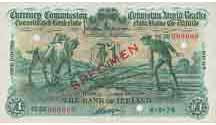
![]()

![]()
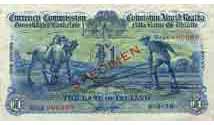
The Central Bank of Ireland Archive, which was opened to public access in 2017, has provided new source material on the Consolidated Bank Notes, the 'Ploughman' series. This is referenced as CBIAR in the text.
The Ploughman Scan Survey (PSS) is a detailed recording of the numbers and grades of the surviving Ploughman Pound notes which has been underway for over 15 years. The survey has resulted in a solid data set of 3,902 Ploughman notes recorded, of which 2,639 are £1 notes.
Information on the numbers of surviving Ploughman One Pound notes is updated periodically in the Ploughman Note Population Report.
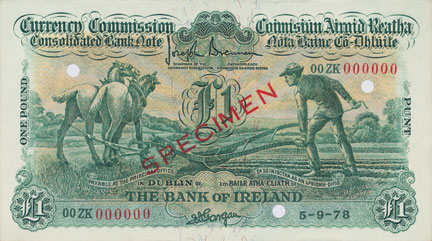
![]()
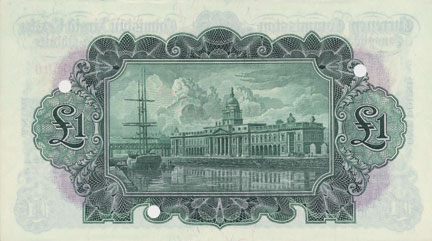
The Consolidated banknotes were designed by artist Dermod O'Brien (1865-1945) [2.].
The One Pound Consolidated Bank Note is primarily green in colour, with a yellow and grey underprint on earlier notes - the 'yellow sun variety' - which changed to an orange and grey underprint on later notes.
The main shade of green was similar to that of the 'Lady Lavery' series Irish One Pound Notes which were first issued in 1928 as legal tender notes in Ireland.
Consolidated Bank Note Colour trials were printed in a range of colours before the final production colours were chosen. Examples of these occasionally turn up.
In addition to official Currency Commission Ploughman specimens, De La Rue specimen samples of Ploughman Irish banknotes were also printed in non-standard colours on non-watermarked paper for use in specimen books as examples of De La Rue printing. All the denominations of the Consolidated Bank Notes were printed as these type of specimens. The One Pound De La Rue Ploughman specimen note was printed in blue.
These De La Rue Ploughman printer's specimens are sometimes described as colour trials.

![]()
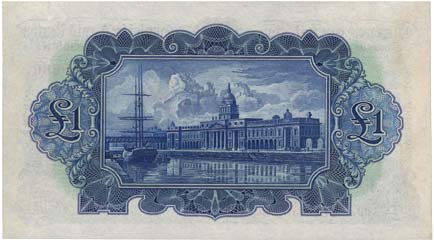
Ploughman Irish pound note De La Rue Specimen [8. Noonans, 2014, Lot 544]
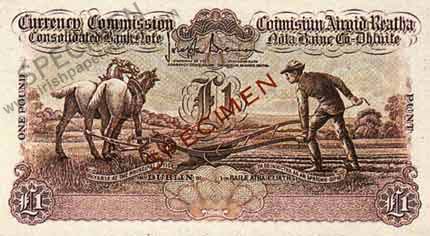
Ploughman One Pound note proof in brown, without bank title
All the text on the face of the Ploughman Irish pound note is bilingual, in English on the left side and in Irish on the right.
The title of the Issuing Authority is at the top of the note: 'Currency Commission Consolidated Bank Note', 'Coimisiún Airgid Reatha Nóta Bainc Có-Dhlúite'.
The main signature, Joseph Brennan [3.], is printed at the top centre of each note, with his title below it in small letters: 'Chairman of the Currency Commission', 'Cathaoirleach Choimisiúin an Airgid Reatha'.
The denomination in words is printed discretely sideways on either side, 'One Pound' on the left, 'Punt' on the right.
In smaller text at the bottom of each Ploughman note is printed 'Payable at the Principle Office in Dublin of', 'Tá so iníoctha ag an bPríomh-Oifig i mBaile Átha Cliath de'.
The name of one of the eight Associated Banks which had the right to issue Consolidated Bank Notes was printed below the 'payable at' text in a separate printing which was added along with the prefix of each banknote. The bank signatory was also added in this printing, directly below the bank title.
Illustrated below is a minor error note on which the printing of the bank of issue and the prefix and serial numbers are all shifted slightly upwards. This illustrates the printing of the bank-specific details on the Consolidated Bank Notes.

![]()

Above is a normally printed Ploughman pound note. Below is a pound note with the bank title, serial numbers and signature shifted slightly upwards, indicating that they were all printed together. Note how the bank title touches the text above it on the lower note
The reverse of the Ploughman One Pound note is printed entirely in green ink, and features a broad view of the Custom House in Dublin, designed by James Gandon (1742-1823) [4.] and constructed in 1791. It is considered to be one of the most important buildings in the city [5.].
The Custom House also has a connection to the Irish 'Lady Lavery' design Legal Tender Notes, issued in 1928, as the reverse design of the Lavery Irish bank notes feature river masks which are part of the design above some of the windows of the Custom House facade.
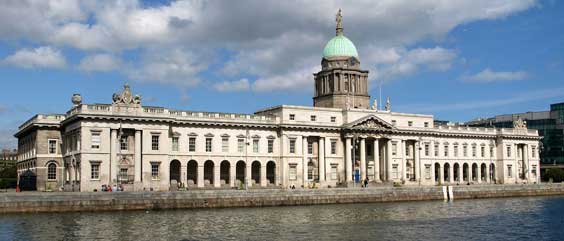
The Custom House, Dublin in 2008. [6. Image copyright Max Mustermann 2008. Image source: https://en.m.wikipedia.org/wiki/File:CustomHouseDublin.JPG]
Illustrated below are two versions of an early design proof for the reverse of the Ploughman one Pound note. The design includes microprinting of 'ONE POUND' repeated which radiates out form the left and right sides of the print area.
This design is reminiscent of that of the reverse of Bank of Ireland Series H one pound notes, 1922-1928, which may have influenced it. The second version labelled 'B' has the microprinting masked out, leaving the design as it was actually used for the production of the one pound Ploughman note.
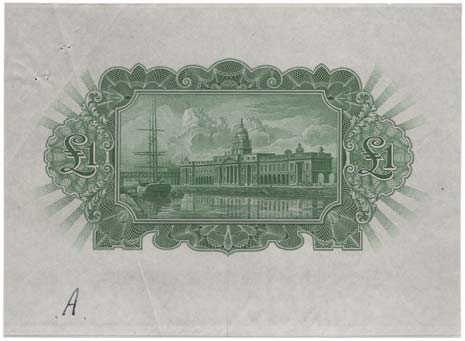

Two pre-production proofs of the Ploughman One Pound note showing a design including microprinting, marked A, and the same design with the microprinting masked out, marked B. The design without microprinting was proceeded with. [7. Noonans, 26 May 2022, Lot 378 and Lot 377]
Below is illustrated a close up of the microprinting on the Ploughman pound note, along with an example of similar microprinting (left) on the reverse of the Bank of Ireland one pound note of the same era, which might have influenced the the Ploughman pound note design

The dimensions of the Consolidated Bank Notes were the same as those of the Legal Tender Notes. The Ploughman one pound note dimensions are 151 x 84 mm. This varies by up to 1 or 2 mm in either dimension. Minor variations in trim size was a common feature on Irish pound notes of this era.
Below are illustrated examples of the first date of a Ploughman one pound note, and the last date for which an example had been seen, 6.2.40. The latest date for which the Ploughman pound notes were printed was 30.4.41 on notes of the Royal Bank of Ireland.
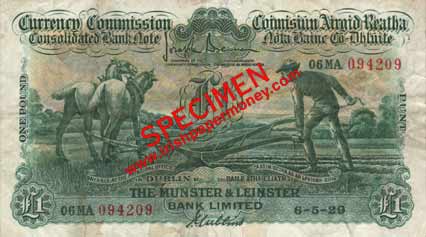
![]()
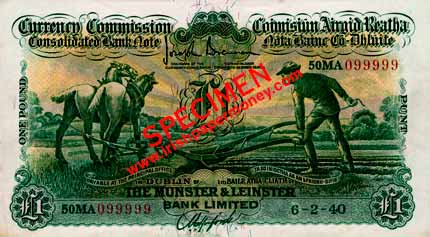
The Ploughman one pound notes were printed in several passes. Initially, a multicolored underprint was printed, leaving knock-outs for the heavier elements of the second printing of the ploughman and horses in green. This was followed by the top printing layer in dark green ink of raised intaglio printing which at the time would have been difficult for forgers to reproduce effectively. Intaglio printing was used on all Irish banknotes issued by the Currency Commission.
The title of the Issuing Authority text on top 'Currency Commission Consolidated Bank Note', 'Coimisiún Airgid Reatha Nóta Bainc Có-Dhlúite' and the signature 'Joseph Brennan' are printed in raised intaglio print which can be easily felt under one's finger, even when the note is well circulated.
In addition to the intaglio printing, the one pound Ploughman notes had a strip of multicolored fibers embedded in the paper which ran down the centre of each note.
This was a common security feature of the time which was used on banknotes of some other countries such as China. The Watermarks and fibre strip on the Irish pound note are visible in the Portals sample paper, pictured below.
The Ploughman one pound notes were printed by Thomas De La Rue Limited on watermarked paper which was manufactured by Portals Limited.
There are four watermarks on the Consolidated One Pound note, one in each corner.
In designing the Irish pound notes, it was considered that a watermark in the heavily printed centre of the note might be difficult to see. This can be the case with the central LTN watermark on the legal tender Lady Lavery banknotes.
Viewed from the face of the note, the watermarks on the Ploughman one pound note are a harp on the left, '£1' on the right, the letters 'CBN' (Consolidated Bank Note) on the bottom left, and a shamrock on the bottom right. The £1 watermark is specific to the Ploughman One Pound note denomination.
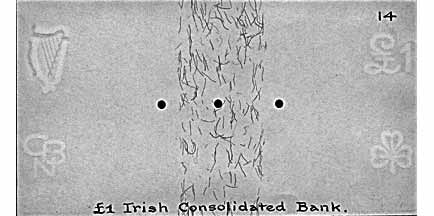
A sample of the watermarked paper for the Ploughman £1 notes from the archive of the manufacturers, Portals, shows the four watermarks on the Ploughman One Pound note as well as the coloured fibres running through the centre of the banknote
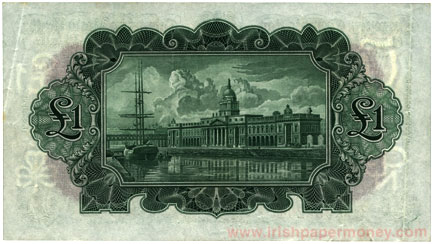
The four watermarks on the One Pound Ploughman are clearly visible when the note is viewed from the reverse side
The Currency Commission 'Ploughman' One Pound note is by far the most common denomination of the attractively designed Consolidated Bank Note series.
Consolidated Bank Notes circulated in modest quantities in Ireland during the Irish Free State era alongside the 'Lady Lavery' Legal Tender Notes, and continued to be accepted in occasional circulation right up to the 1960s.
All eight Associated Banks made considerable usage of the One Pound Consolidated Bank Notes, with Bank of Ireland accounting for approximately 40% of the total number of these £1 Ploughman notes issued.
Examples of Ploughman notes from the Northern Bank are the scarcest with just four prefixes used. The 1929 Northern Bank notes (Knox signature) are very rare, and by far the rarest of all the Ploughman One Pound notes.
Generally 1929 is the scarcest year for the one pound notes of all the banks.
Bank of Ireland was the largest issuer of £1 notes, being the only bank to complete the initial prefix A of 01-99 notes, and continuing up to prefix 09BB by 1939.
Bank of Ireland, Munster & Leinster Bank (used to prefix 44MA), and National Bank (used to 44NA) are the most common banks for the Ploughman one pound notes, with those of the Provincial Bank of Ireland (used to 24PA) and the Hibernian Bank (printed to 24HA) being somewhat scarcer, though still easy to obtain. Royal Bank of Ireland Ploughman pound notes are quite a bit less common, with 28 prefixes issued. Ulster Bank Ploughman pound notes are significantly rarer, with prefixes used up to 12UA.
Actual printage figures for the Ploughman one pound notes were higher, but much of these notes were not issued, such as those with dates in 1940. Munster & Leinster Bank Prefix 50MA is on Consolidated One Pound Notes dated 6 February 1940. These notes were not issued. Some examples were kept by the Central Bank of Ireland and are now in their archive. An example of the Munster & Leinster Bank £1 Ploughman, 6.2.40, from the Central Bank archive is illustrated above.
Ploughman One Pound notes ceased production after the Currency Commission Ireland was wound up and replaced by the Central Bank of Ireland. The notes continued to be issued and redeemed by the banks past this era.
On 31 December 1953 all issues ceased, and the Central Bank of Ireland became the sole issuer of banknotes in Ireland.
As a design, the Ploughman one pound note is common, and it is quite feasible to acquire a presentable example of one of the common banks without much difficulty or expense.
Based on the Consolidated Bank Note Population Report from the Ploughman Scan Survey, the relative rarity of the banks for Ploughman one pound notes is as follows:
Bank of Ireland (34%), National Bank (19.7%), Munster & Leinster Bank (12.9%), Royal Bank of Ireland (10.5%), Provincial Bank of Ireland (9.7%), Hibernian Bank (8%), Ulster Bank (5.6%), Northern Bank (2.4%).
Illustrated below is an example of a Ploughman one pound note of each of the eight banks.

![]()

![]()

![]()

![]()
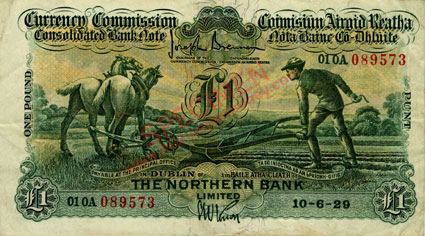
![]()

![]()
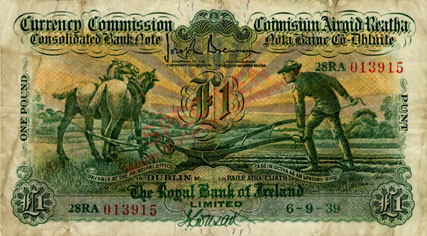
![]()
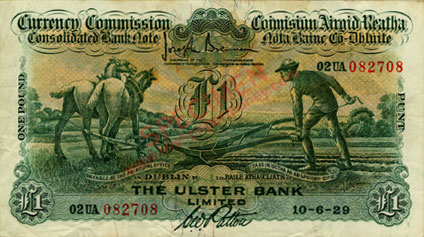
There are 18 signature varieties across the eight banks for the £1 Consolidated Bank Note.
Of the 18 signatures, one was never issued, and only one of the remainder is rare: Northern Bank one Pound with Knox signature, with only ten examples recorded in the Consolidated Bank Note Population Report. There are two dates for this signature, 6 May 1929 and 10 June 1929.
An example of all of the other 16 signatures would be relatively easy to obtain.
Bank of Ireland: Gargan 1929-1938, Johnston 1939-1940.
Hibernian Bank: Campbell 1929-1939, Hodges 1939-1940.
Munster & Leinster Bank: Gubbins 1929-1935, Hosford 1936-1940.
National Bank: Russell 1929-1940.
Northern Bank: Knox 1929, Stewart 1931, (Tibbey 1939-1940 never issued).
Provincial Bank of Ireland: Robertson 1929, Fforde 1931-1936, Kennedy 1937-1940.
Royal Bank of Ireland: Stanley 1929-1931, Mack 1931-1939, Wilson 1939-1941.
Ulster Bank: Patton 1929-1935, Lester 1936-1940.
References [Last retrieved 14.08.24]
1
2. Dermod O'Brien (1865-1945) < https://www.dib.ie/biography/obrien-dermod-a6460p >
3. Joseph Brennan (1887-1976) < https://www.dib.ie/biography/brennan-joseph-a0938 >
4. James Gandon (1742-1823) < https://www.dib.ie/biography/gandon-james-a3418 >
5. Custom house, Dublin < https://www.archiseek.com/2010/1791-custom-house-customhouse-quay-dublin >
6. Custom house, Dublin < https://en.m.wikipedia.org/wiki/File:CustomHouseDublin.JPG >
7. Noonans, Mayfair. Auction catalogue 'Banknotes' 26 May 2022.
8. Noonans, Mayfair. Auction catalogue 'British and Irish Banknotes' 14 March 2024.
1 Pound Ploughman
5 Pounds Ploughman
10 Pounds Ploughman
20 Pounds Ploughman
50 Pounds Ploughman
100 Pounds Ploughman
Irish Ten Shilling Notes
1 Pound Note Lady Lavery
5 Pounds Lady Lavery
10 Pounds Lady Lavery
20 Pounds Lady Lavery
50 Pounds Lady Lavery
100 Pounds Lady Lavery
1 Pound Note, Queen Medb
5 Pound Note, John Scotus Eriugena
10 Pound Note, Jonathan Swift
20 Pound Note, W. B. Yeats
50 Pound Note, Turlough O'Carolan
100 Pound Note, Grace O'Malley
5 Pound Note, Sister Catherine McAuley
10 Pound Note, James Joyce
20 Pound Note, Daniel O'Connell
50 Pound Note, Douglas Hyde
100 Pound Note, Charles Stewart Parnell
Northen Ireland Polymer notes
Bank of Ireland Polymer Notes
Danske Bank Polymer Notes
Ulster Bank Polymer Notes
Special Sections and Articles
The Transition of Irish Currency, Irish banknotes 1918–1928
The Partition of Irish Currency, Irish banknotes 1928–1930
Banknote Design Evolution 1824 to 1916
Irish Three Pound Notes
Contemporary Forgeries of Early Irish Banknotes, ca1800-1930
Limerick Soviet Notes
Irish World War 2 Banknote Issues
Low Number Irish Banknotes
Irish Joint Stock Banks of Note Issue from 1783
Irish Legal Tender Note Specimens
Ploughman Scan Survey (PSS)
![]() Stable version. Last update 14.09.24.
Stable version. Last update 14.09.24.